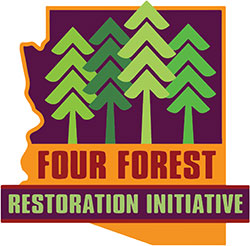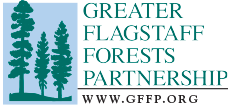
The Four Forest Restoration Initiative (4FRI) is a collaborative effort to restore forest ecosystems on portions of four National Forests – Coconino, Kaibab, Apache-Sitgreaves, and Tonto – along the Mogollon Rim in northern Arizona.
Ponderosa pine forest stretches almost continuously from the south rim of the Grand Canyon, across the Mogollon Rim, to the White mountains in eastern Arizona.
Unfortunately, these forests have been degraded by unsustainable historical land uses and fire exclusion. The result is overgrown forests with thin, unhealthy trees and the threat of unnaturally severe wildfire.
The vision of 4FRI is restored forest ecosystems that support natural fire regimes, functioning populations of native plants and animals, and forests that pose little threat of destructive wildfire to thriving forest communities, as well as support sustainable forest industries that strengthen local economies while conserving natural resources and aesthetic values.
GFFP regularly participates in the 4FRI stakeholder group and, through our work and grants received, has made a substantial contribution to increasing capacity and funding toward the Initiative.
GFFP continues to work with the 4FRI Multi-Party Monitoring Board to plan and conduct projects like songbird, forest structure and vegetation inventories.
In 2017, GFFP secured two grants from Coconino County and Arizona Dept. of Forestry and Fire Management to support an economic monitoring program to analyze the regional economic contributions of 4FRI-related projects.
Collectively, these efforts assist in conducting monitoring projects that better determine 4FRI effectiveness. Based on monitoring results, application of lessons learned promotes enhanced economic, social and ecological outcomes and programmatic sustainability.
Four Forest Restoration Initiative’s Multiparty Monitoring Board’s Purpose Statement
In 2010, the Four Forest Restoration Initiative was selected for funding under the Collaborative Forest Landscape Restoration Program (CFLRP). The purpose of the CFLRP is to encourage collaborative, science-based ecosystem restoration of priority forest landscapes.
This program establishes that multiparty monitoring will be used to determine the ecological, social, and economic effects of management actions within the project landscape. A Multiparty Monitoring Board (MPMB) of the 4FRI Stakeholder Group was established to monitor and evaluate these effects. The MPMB’s members provide support and expertise in the development and implementation of ecological and socioeconomic monitoring. This group also helps evaluate and communicate the results of monitoring activities to stakeholders and to the public.
The MPMB strives to represent a variety of interests and partners. Members currently include
- Arizona Game and Fish Department
- Campbell Global
- Center for Biological Diversity
- Ecological Restoration Institute
- Grand Canyon Trust
- Greater Flagstaff Forests Partnership
- Mottek Consulting
- Salt River Project
- The Nature Conservancy
- The Rocky Mountain Research Station
- Trout Unlimited
Adaptive Management
The intent of monitoring is to link land management actions and outcomes with learning. Monitoring is a valuable tool that can help the 4FRI adapt its management practices based on the effects of previous activities. The Forest Service and the stakeholder group collaboratively developed a monitoring and adaptive management plan to describe how the Forest Service and its partners will monitor the effects of 4FRI restoration treatments and, based on changing conditions and new information, how future actions will be adapted to achieve desired results.
Current Activities

4FRI Brochure
In partnerships with organizations like the Landscape Conservation Initiative at Northern Arizona University, the Bird Conservancy of the Rockies, and The Nature Conservancy, ecological monitoring is already underway covering issues ranging from changes in forest vegetation to changes in songbird communities. The health and condition of springs across the 4FRI are being monitored by the Spring Stewardship Institute of the Museum of Northern Arizona. In addition, the regional economic contributions of 4FRI-related projects are being analyzed by Conservation Economics Institute.
Through the efforts of other partner organizations such as the Grand Canyon Trust and Trout Unlimited, volunteer citizen scientists are being brought together to help the Forest Service assess the condition of various streams and springs throughout the 4FRI landscape. These assessments will help the Forest Service develop and implement restoration plans that will improve the quality and resilience of these valuable wildlife habitats.
Since many biophysical monitoring efforts include gathering data on both pre-treatment conditions and post-treatment activities, results may take some time. As monitoring reports are completed, The MPMB will post report links to the U.S. Forest Service website.
If you are interested in volunteering with the monitoring effort, please see the 4FRI’s Get Involved page.


